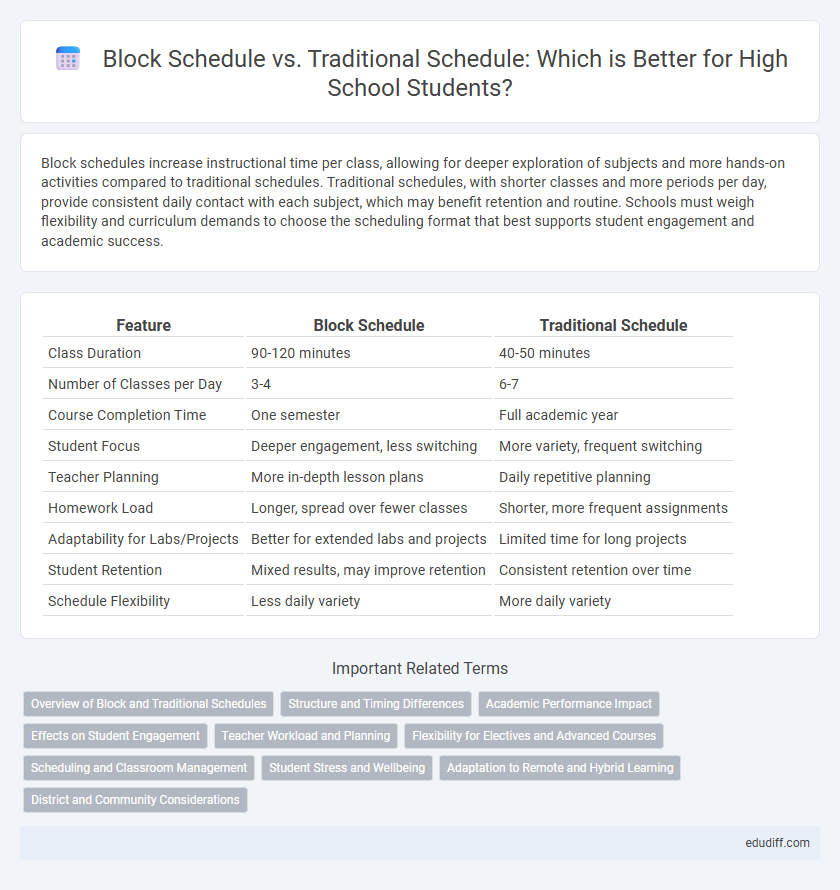Block schedules increase instructional time per class, allowing for deeper exploration of subjects and more hands-on activities compared to traditional schedules. Traditional schedules, with shorter classes and more periods per day, provide consistent daily contact with each subject, which may benefit retention and routine. Schools must weigh flexibility and curriculum demands to choose the scheduling format that best supports student engagement and academic success.
Table of Comparison
| Feature | Block Schedule | Traditional Schedule |
|---|---|---|
| Class Duration | 90-120 minutes | 40-50 minutes |
| Number of Classes per Day | 3-4 | 6-7 |
| Course Completion Time | One semester | Full academic year |
| Student Focus | Deeper engagement, less switching | More variety, frequent switching |
| Teacher Planning | More in-depth lesson plans | Daily repetitive planning |
| Homework Load | Longer, spread over fewer classes | Shorter, more frequent assignments |
| Adaptability for Labs/Projects | Better for extended labs and projects | Limited time for long projects |
| Student Retention | Mixed results, may improve retention | Consistent retention over time |
| Schedule Flexibility | Less daily variety | More daily variety |
Overview of Block and Traditional Schedules
Block schedules consist of fewer, longer class periods each day, often 90 minutes, allowing for in-depth instruction and project-based learning. Traditional schedules feature more frequent, shorter periods, typically 45-50 minutes, promoting daily content review and routine. Both scheduling models impact student engagement, teacher planning, and curriculum delivery in distinct ways.
Structure and Timing Differences
Block schedules condense classes into longer periods, typically 90 minutes, allowing students to focus on fewer subjects per day while completing courses in a semester instead of a full year. Traditional schedules consist of shorter, 45 to 50-minute classes meeting daily throughout the academic year, promoting consistent daily engagement with each subject. The block schedule's extended periods support deeper learning and project-based activities, whereas the traditional schedule emphasizes routine and daily reinforcement.
Academic Performance Impact
Block schedules improve academic performance by allowing longer, focused class periods that enhance student engagement and deeper learning. Traditional schedules often lead to fragmented attention due to shorter, more frequent classes, which can hinder comprehension and retention. Studies show students in block schedules achieve higher test scores and better grade point averages compared to those in traditional schedules.
Effects on Student Engagement
Block schedules increase student engagement by allowing extended periods for in-depth exploration of subjects, fostering active participation and reducing transitions between classes. Traditional schedules may limit engagement due to shorter class times and frequent interruptions that hinder sustained focus. Research shows students in block schedules report higher motivation and involvement, improving academic performance and classroom interaction.
Teacher Workload and Planning
Block schedules reduce teacher workload by allowing longer class periods, which enable deeper lesson development and fewer daily preparations. Traditional schedules require teachers to plan for multiple shorter classes, increasing daily task switching and preparation time. Effective planning under block schedules supports more focused instruction and improved time management for educators.
Flexibility for Electives and Advanced Courses
Block schedules offer greater flexibility for students to enroll in a wider variety of electives and advanced courses by allowing longer, focused class periods that accommodate in-depth learning and project work. Traditional schedules, with shorter class periods and more frequent meetings, often limit the number and depth of electives a student can take due to time constraints. This flexibility in block scheduling supports personalized academic pathways and better preparation for college-level coursework.
Scheduling and Classroom Management
Block schedules create longer class periods that enable in-depth exploration of subjects and reduce transition times, which enhances classroom management and minimizes disruptions. Traditional schedules offer shorter, more frequent classes that allow for consistent daily reinforcement but can lead to increased movement and potential interruptions between periods. This structural difference significantly impacts how teachers allocate instructional time and manage student behavior throughout the school day.
Student Stress and Wellbeing
Block schedules can reduce student stress by allowing longer class periods for deeper understanding and fewer class transitions per day, promoting better focus and time management. Traditional schedules, with shorter class periods and more frequent transitions, may increase anxiety due to rapid subject changes and heavier daily workload. Research indicates that block scheduling supports improved student wellbeing by balancing academic demands and providing more time for rest and extracurricular activities.
Adaptation to Remote and Hybrid Learning
Block schedules enhance flexibility in remote and hybrid learning by allowing longer class periods that accommodate in-depth virtual discussions and project-based activities, improving student engagement and comprehension. Traditional schedules often struggle with frequent transitions between subjects, which can disrupt continuity and hinder the effective use of digital tools. High schools adopting block scheduling report smoother adaptation to online platforms, as extended periods reduce the challenge of managing multiple logins and fragmented instruction time.
District and Community Considerations
Districts must evaluate resource allocation, instructional time, and teacher workload when choosing between block and traditional schedules, ensuring alignment with community values and student needs. Community involvement is crucial, as parental preferences and local cultural factors influence support and student engagement. Data on academic outcomes and extracurricular participation also guide districts in balancing schedule benefits with community priorities.
Block Schedule vs Traditional Schedule Infographic

 edudiff.com
edudiff.com